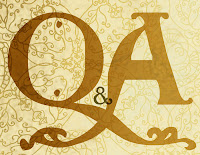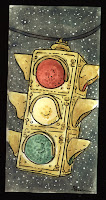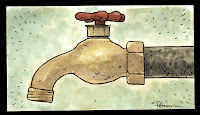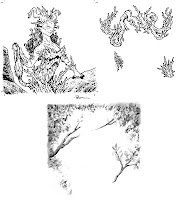 Questions and Answers:
Questions and Answers:
A few of the same questions hit my email on a regular basis and today I thought I'd address a few of them here for everyone to read.I figure that if a question is being asked by a few, it's something that may interest the many. If you would like to submit a question for a future Q&A blogpost, email me through the
mouseguard.net site or
Twitter or
Facebook.
Q: How you handle just a bad day artistically? What has worked & what hasn't?
A: I don't handle them well, that's for sure. I have two basic approaches 1) Walk Away or 2) Push Through. Depending on the situation I may try either or both of those. To walk away doesn't mean necessarily to give up. It can mean to take a break. In that break I may take a hot shower (something that almost always clears my head and improves my mood) play a game, watch TV or a movie, read a book, go for a bike ride, or it very well might mean quit for the day. The break can serve to purposefully inspire you or it may just be the mental distraction you need to clear your head and get back into a good place. Other times it's just coming back tomorrow and seeing where you stand...but more than a few of those days and you are in serious trouble.
Pushing through can be a tricky one. It means that you are going to force yourself to do bad drawings and work that makes you perhaps madder than you are when considering 'how do I get past this bad artistic day'. It's a "darkest before the dawn" scenario. And it doesn't always work. Trying to draw the character on a new sheet of paper can help (put away the bad drawings) focusing on a new part of the drawing, or if working on a layout, change the camera angle or panel size to something drastically different and see what happens...even if you hate it, by seeing what you hate about it, you may find what you like and need to focus on for a better layout
The only surefire's for me to kick the bad art days (or at least the most reliable) include keeping in touch with other creatives (even if just to verbalize your issues with the work you are unhappy with, if not to also share jpgs of process work), the hot shower mentioned above, and staying fed & rested on a schedule.
Q: What are your thoughts on college or art school for a future in illustration/comics. Are there classes you recommend?
A: First off, to get a job working in illustration or comics (which can sometimes just mean producing work and self-publishing it) no one will ever check to see if you have a degree and if so, what kind. The gates to art employment won't be barred to you because you didn't go to college. The chief criteria for getting work is: can you do the work well...which is to say, can you draw, illustrate, & tell stories well....AND can you prove it. That being said, college and art schools can help you become a better artist. Their programs are designed to do so.
Then you get into the debate of structured educational learning of art vs self exploration & study. Both have benefits and detriments. School gives structure, a social web of like-minded creatives to bounce ideas off of, and a forced schedule for getting work done...however, it can also be as good or flawed as the professors who have tenure and it costs a great deal of money. Self study focuses on what you want to learn, costs little, and leaves you more artistic freedom ..but can be tricky to stick with & push yourself hard enough and won't expose you to as much artistic diversity as school.
I started at a community college for two years, and then transferred to a university. At the time of the transfer, I also considered an art school, but decided I wanted to experience the college campus life and not leave all my non artistic studies behind (science, literature, etc.). The two most important classes I took were 2D design (
which I've posted about before) and Printmaking (which I've posted on a few times
A,
B,
C) The artistic education was sturdy, and certainly forced me outside of my comfort zone, but I found the lack of illustration classes at my school and the desire of professors to re-mold you into their artistic image a step backwards. So do you need a college degree for this line of work? I think the question needs to be What do you think you need to get your work ready for this line of work?.
Q: What materials do you use?
A: Paper: Strathmore sketchbooks & 300 series bristol
Drawing: A 0.5mm mechanical pencil with HB lead & a kneaded eraser
Inking: Copic Multiliners (the 0.7 nib mainly) Dr. Martin's Bombay Black ink and a #1 brush for fills or brushwork
Watercolor: I have a few Sakura portable trays and an assortment of Windsor Newton tubes (especially their Payne's Grey)
Digital Coloring: Photoshop 7.0
 Watercolor Wednesday:
Watercolor Wednesday:
Last week's watercolor pieces were of inanimate objects. First up is a traffic signal. Mr. Rogers had one in his house, and when I was a kid I thought it would be a cool item to have in your home...not one of those novelty ones, but a real, weathered, street-used traffic signal. Of the three pieces from last week, I painted this last asking myself "what other object that we all see every day would be interesting enough to paint" and my mind flashed to that childhood desire to own one of these.

The spigot came first in the order of these being painted. I was in my basement laundry room and saw the shut-off valve in the floor joists for the outside spigot and thought the valve looked cool and would be interesting to paint. But when I sat down to draw it, I thought showing a spigot would be more interesting for someone to own than just a valve.

Last up from last week's pieces is a pair of scissors. My friend Mike Davis (who is the inspiration for Rand) did a lot of college sketchbooks themed around him drawing every day objects over and over: utensils, eyelash curlers, drafting implements, simple hand tools...and I think he did a page on scissors too. Anyhow, that flashed to mind after the spigot painting and I aped his idea to do this pair of scissors.
2013 Appearances:
*more 2013 dates coming*
 Game illustrations:
Game illustrations: Watercolor Wednesday:
Watercolor Wednesday: 
































